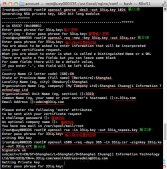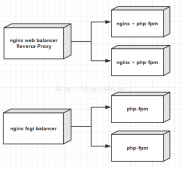前言
近期写个小demo,因为用到某大厂的在线数据,接口做了跨域限制,所以利用Nginx代理来解决这些问题。
1. nginx.conf 配置信息
由于nginx.conf配置信息较多,本篇只关注跟axios和静态资源请求设置,顺便也将常见的一些配置项备注一下。具体设置如下:
|
1
2
3
4
5
6
7
8
9
10
11
12
13
14
15
16
17
18
19
20
21
22
23
24
25
26
27
28
29
30
31
32
33
34
35
36
37
38
39
40
41
42
43
44
45
46
47
48
49
50
51
52
53
54
55
56
57
58
59
|
# 设定http服务器,利用它的反向代理功能提供负载均衡支持http { #连接超时时间 keepalive_timeout 120; #gzip压缩开关及相关配置 gzip on; gzip_min_length 1k; gzip_buffers 4 32k; gzip_http_version 1.1; gzip_comp_level 2; gzip_types text/plain application/x-javascript text/css application/xml; gzip_vary on; gzip_disable "MSIE [1-6]."; #设定实际的服务器列表 upstream zp_server{ server 127.0.0.1:8089; } #HTTP服务器 server { #监听80端口 listen 80 #定义服务名称 server_name localthost; #首页 index index.html #指向项目根目录 root D:\project\src\main\webapp; #编码格式 charset utf-8; #代理的路径(和upstream绑定),location 后面设置映射的路径 location / { #代理配置参数 proxy_connect_timeout 180; proxy_send_timeout 180; proxy_read_timeout 180; proxy_set_header Host $host; proxy_set_header X-Forwarder-For $remote_addr; proxy_pass http://zp_server/; #跨域相关设置 add_header 'Access-Control-Allow-Origin' '*' always; add_header 'Access-Control-Allow-Credentials' 'true'; add_header 'Access-Control-Allow-Headers' 'Origin, X-Requested-With, Content-Type, Accept' always; } #配置静态资源 解决js css文件无法加载无法访问的问题,注意末尾不能有 / location ~ .*\.(js|css|jpg|png)$ { proxy_pass http://zp_server; } }} |
2. proxy_pass的斜杠问题
Nginx的官网将proxy_pass分为两种类型:
- 一种是只包含IP和端口号的(连端口之后的/也没有,这里要特别注意),比如proxy_pass http://localhost:8080,这种方式称为不带URI方式;
- 另一种是在端口号之后有其他路径的,包含了只有单个/的,如proxy_pass http://localhost:8080/,以及其他路径,比如proxy_pass http://localhost:8080/abc。
2.1 对于不带URI方式
对于不带URI方式,Nginx将会保留location中路径部分,比如:
|
1
2
3
|
location /api1/ { proxy_pass http://localhost:8080;} |
在访问http://localhost/api1/xxx时,会代理到http://localhost:8080/api1/xxx
2.2 对于带URI方式
对于带URI方式,nginx将使用诸如alias的替换方式对URL进行替换,并且这种替换只是字面上的替换,比如:
|
1
2
3
|
location /api2/ { proxy_pass http://localhost:8080/;} |
当访问http://localhost/api2/xxx时,http://localhost/api2/(注意最后的/)被替换成了http://localhost:8080/,然后再加上剩下的xxx,于是变成了http://localhost:8080/xxx。
2.3 总结一下
|
1
2
3
4
5
6
7
8
9
10
11
12
13
14
15
16
17
18
19
20
21
22
23
24
25
26
27
28
29
30
31
32
33
34
35
36
37
38
39
40
41
42
43
44
45
46
47
48
|
server { listen 80; server_name localhost; location /api1/ { proxy_pass http://localhost:8080; } # http://localhost/api1/xxx -> http://localhost:8080/api1/xxx location /api2/ { proxy_pass http://localhost:8080/; } # http://localhost/api2/xxx -> http://localhost:8080/xxx location /api3 { proxy_pass http://localhost:8080; } # http://localhost/api3/xxx -> http://localhost:8080/api3/xxx location /api4 { proxy_pass http://localhost:8080/; } # http://localhost/api4/xxx -> http://localhost:8080//xxx,请注意这里的双斜线,好好分析一下。 location /api5/ { proxy_pass http://localhost:8080/haha; } # http://localhost/api5/xxx -> http://localhost:8080/hahaxxx,请注意这里的haha和xxx之间没有斜杠,分析一下原因。 location /api6/ { proxy_pass http://localhost:8080/haha/; } # http://localhost/api6/xxx -> http://localhost:8080/haha/xxx location /api7 { proxy_pass http://localhost:8080/haha; } # http://localhost/api7/xxx -> http://localhost:8080/haha/xxx location /api8 { proxy_pass http://localhost:8080/haha/; } # http://localhost/api8/xxx -> http://localhost:8080/haha//xxx,请注意这里的双斜杠。} |
总结
以上就是这篇文章的全部内容了,希望本文的内容对大家的学习或者工作具有一定的参考学习价值,谢谢大家对服务器之家的支持。
原文链接:https://segmentfault.com/a/1190000020027003
















